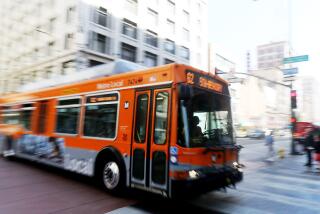RTD Defends Rookie Driver’s Supervision
- Share via
Southern California Rapid Transit District officials said Friday that they are convinced that the rookie driver involved in Thursday’s Hollywood Freeway bus spill in which 27 people were injured had been adequately supervised by the line instructor who was looking over her shoulder when the crash occurred.
Driver Shirley Jean Riojas, 26, who had only 18 days of RTD training and still had only a learner’s permit, has suggested the contrary.
Riojas complained in a television interview after the crash that she had received inadequate advice and warning from line instructor Raul Lewenberg, 37, as she tried to turn the bus off the freeway to stop under the Western Avenue overpass for passengers. Instead, the bus struck the curb on the right-hand side of the turnout lane and flipped over, injuring most of the passengers.
Several passengers and witnesses said they thought Riojas was driving too fast. The accident was the fifth RTD mishap this year in which more than a dozen passengers were hurt.
As RTD executives began reviewing the accident, questions were raised about their past assertions that their system has a lower accident rate than the national average. Some statistics obtained by The Times suggest the rate is slightly higher than the national average.
RTD Transportation Director Ed Nash said Friday that checks of RTD records showed that in the five days Riojas had been driving Route 424 between downtown Los Angeles and Northridge, she had turned into the Western Avenue passenger pickup lane a total of nine times.
“The gal goes by that same stop nine times, and you’re the line instructor and you say, ‘Well, certainly she knows how to enter and exit that bus stop OK.’ And the 10th time, she straddles the island.”
Nash added later: “The line instructor was sitting in the seat directly behind her. There was no plastic facade between them. He can talk over the operator’s shoulder. She’s not looking at him. How could she make an assessment of what he was doing? The gal’s going to make statements, because her job is on the line.”
Meanwhile, the RTD’s safety director, Joseph G. Reyes, said instructor Lewenberg had been interviewed shortly after the crash and he had insisted that he had exercised prudent supervision.
Nonetheless, Nash said the RTD is reviewing Lewenberg’s “file to see whether he should remain a line instructor,” just as it is trying to determine Riojas’ future.
Neither Riojas nor Lewenberg could be reached Friday for comment.
The California Highway Patrol is conducting the formal accident investigation, but a spokeswoman said its report will not be ready for two or three weeks.
Meanwhile, both officials of the RTD and the state Department of Motor Vehicles confirmed Friday that Lewenberg had had two accidents, including one with an RTD bus last Jan. 22, and four citations, including three for speeding and one for a turning violation, in the last three years in his personal driving.
Record Won’t Disqualify Him
However, Nash and Reyes said the record in itself would not disqualify Lewenberg from continuing to serve as a line instructor.
They said that only if he had been ruled at fault in an RTD accident or had actually been arrested and booked in one of the citations would action have been taken against him.
Although RTD lawyers said the district would not discuss the nature of Lewenberg’s earlier bus accident, because, according to a spokesman, “there’s potential for litigation,” Nash said the RTD is satisfied that Lewenberg was not at fault in the accident.
Another RTD executive, Ralph Wilson, said the RTD also would not be interested in Lewenberg’s personal driving record, his speeding citations, unless there had been “gross misconduct.” He said this would be indicated by an actual booking, and none occurred.
In another matter, Nash said the RTD could not confirm Riojas’ statements after the crash that the bus speedometer was broken and she could not tell how fast she was going when she hit the turnout lane.
Cards Impounded
Nash said drivers routinely fill out cards showing all such mechanical malfunctions, and an inoperative speedometer would be cause for removing the bus from service. However, he said that since the cards had been impounded by the CHP, he did not know whether such a malfunction had been reported.
The CHP spokeswoman said the investigators had custody of the cards and other materials and she did not have information on the condition of the speedometer.
In the days before Thursday’s accident and again on Friday, RTD officials stated repeatedly that the RTD accident rate has been declining and, in any event, is below the national average.
Spokesman Mark Littman, for example, said recently that the national average for urban mass transit is 5.9 accidents per 100,000 miles, while the RTD’s rate has declined from 5.1 accidents for every 100,000 miles in fiscal 1984 to 4.4 in the fiscal year that ended Wednesday.
National Average
Nash asserted on Friday that the national average was eight accidents for every 100,000 miles.
“We put, from the time the first bus rolls out this morning, until the last one rolls tonight, we put on 355,000 miles. We service 19,942 stops. We move over a million and a half people.
“Our rate per 100,000 miles was 4.2 accidents (in July) per 100,000 miles. The national average is eight accidents per 100,000 miles, and if you check the munis (municipal transit systems) in this area, their accident rate’s about 11 per 100,000 miles. So what I’m saying is, you’re focusing on RTD, but our track record’s not that bad.”
According to the National Safety Council, the national average accident rate for city buses in 1984 was 3.7 per 100,000 miles, substantially under the Los Angeles rate then or since.
Nash and Reyes, shown the figures and asked for comment, said Friday night that the National Safety Council counts some things as accidents that the RTD does not and it does not count certain things that the RTD does, so, they said, the figures are not comparable.
Traffic Congestion
In addition, Nash and Littman said they think it is unfair to include transit systems in smaller cities and metropolitan areas that do not have the traffic congestion of Los Angeles.
Littman said that when RTD officials say they are under the national average, they are relying on some comparisons they have done with a select number of other cities and some comparisons that Minneapolis transit authorities have done.
He released some Minneapolis figures showing that the RTD had, in some respects, a better accident record than transit systems in Seattle, Boston, Philadelphia, Washington and San Francisco.
For instance, according to the study, the RTD had only one accident per 135,037 passenger miles in July, 1985, compared to one for 124,266 for Seattle, 96,657 for Boston and 93,662 for Philadelphia.
In no case, for three separate months in 1984 and 1985, was Los Angeles any worse than any of the other five cities in average miles per passenger accident, although it was somewhere in the middle in average miles per vehicle accident.
Ratio of Injuries
In terms of injuries, however, according to statistics issued by the federal Urban Mass Transit Authority in 1984, the RTD’s ratio of injuries to passenger miles in 1983 was nearly twice that of New York, even though both cities had roughly the same rate of accidents per passenger miles.
Buses in both cities were driven about 140 million miles, and RTD buses were involved in 7,001 collisions, compared to 6,651 for New York. However, while RTD accidents resulted in 2,819 injuries, New York’s resulted in 1,447.
The RTD’s injury rate was three times higher in the report than San Francisco’s and San Diego’s and eight times higher than Sacramento’s.
As of Friday night, five of the 21 bus passengers admitted to five area hospitals remained hospitalized.
A bus rider identified only as Lois Weldon was in stable condition at Hollywood Presbyterian Medical Center. Anne Goldstein, 70, remained in serious condition with a fracture of the pelvis at Cedars-Sinai Medical Center.
Blanca Alvarez, 29, was in stable condition at Queen of Angels Medical Center, where Esther Rudnick, 63, and Ronnie Linthicum, 21, remained in satisfactory condition.
More to Read
Sign up for Essential California
The most important California stories and recommendations in your inbox every morning.
You may occasionally receive promotional content from the Los Angeles Times.













